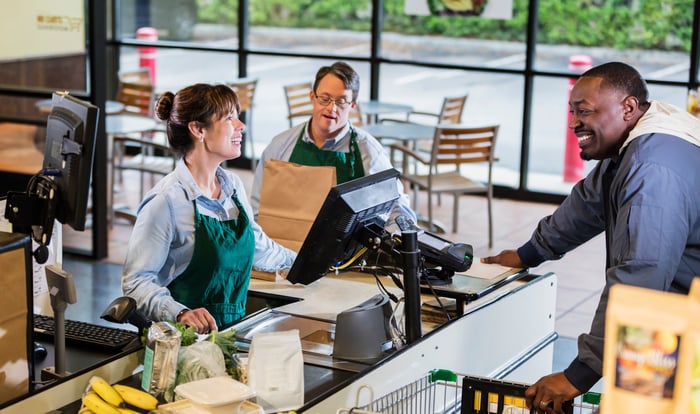Procter & Gamble (PG -0.13%) performed very strongly through the inflation spike that occurred following coronavirus pandemic disruptions to supply chains, heated inflation, and rising interest rates. But the stock is trading within 5% of its all-time highs. That said, the company's performance has been weakening. Is it worth buying the stock?
Procter & Gamble is a high performing industry leader
The first thing to know about Procter & Gamble is that it is a consumer staples behemoth, with a roughly $380 billion market cap. The company's products tend to reside at the high end of the market and it works hard to justify that positioning by using research and development to ensure its products offer tangible benefits. Not only does the company's size allow it to spend heavily on R&D, but it can also support its brands with marketing attention and a strong distribution network.

Image source: Getty Images.
In short, P&G, as the company is often called, is a key partner for retailers across the world. Adding more value to these relationships is the fact that the company owns some of the best known brands in the segments it serves, including names like Bounty, Crest, Old Spice, Tide, Gillette, and Pampers, among many others. Even if you don't actively use P&G's brands, you probably know about them.
Over the last few years, Procter & Gamble has performed pretty well. Specifically, in the face of inflation, it was able to push through sizable price increases with astonishing success. For example, in fiscal 2023 organic sales increased 7%, 5%, 7%, and 8% sequentially across the four quarters of the year. Those are very big numbers in the consumer staples space. But there was more to the story, as P&G was able to increase its market share in 31 out of its 50 most important category/country combinations that year.
Things are getting harder, not easier for P&G
But with three quarters already in the books in fiscal 2024, P&G's performance is slowing down. For example, through the first three quarters of fiscal 2024, the company is only gaining share in 28 of its top 50 category/country combinations. And if you look further back, even the 31 that were up in fiscal 2023 was down from 38 in 2022.
Looking at organic sales, meanwhile, the peak of the recent cycle was in the fourth quarter of fiscal 2023 at 8%. The numbers have been heading steadily lower since that point, hitting 3% in the fiscal third quarter of 2024.
To be fair to P&G, 3% isn't a bad number in the consumer staples sector, which is generally known for slow and steady performance. But it is still less than half of the organic growth the company was posting just a few quarters ago. That makes sense as P&G laps large price increases, but it still highlights that the business environment is getting harder, not easier.
The interesting thing is that the stock price has remained fairly resilient. The stock is less than 5% below its all time high, reached in calendar year 2022. That suggests that P&G might be expensive. However, the price to earnings and price to cash flow ratios are below their five year averages. The price to sales and price to book value ratios are above the longer-term averages, but not by much. So the stock perhaps looks reasonably valued, noting that the 2.5% dividend yield is about middle of the road historically speaking.
Not a screaming buy, but not exactly unattractive
If you are a value investor, you probably won't be attracted to P&G at the current prices. The story could be very different if you are a growth and income investor, noting that this Dividend Kings' 2.5% yield is well above the 1.3% on offer from the S&P 500 Index. This is not a back-up-the-truck type of moment, but if you are trying to find a high-performing industry leader in the consumer staples space, Procter & Gamble should probably be on your short list. And even if you don't decide to buy it, you might want to put it on your wish list just in case of a broad market sell off.






